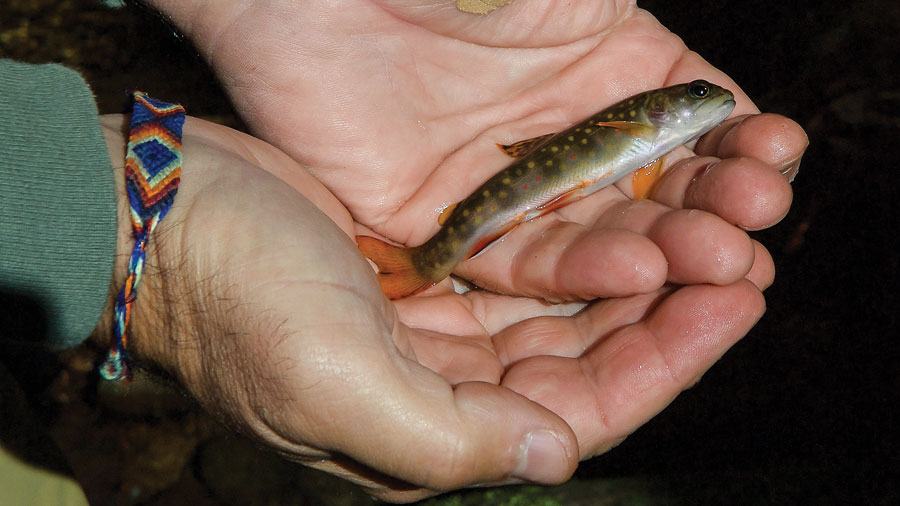
I must step around the delicate bluets that dot the trail beside Bonnie Brook. On either side of the path, dandelions rise from wild tufts of grass. Sprinkled through the unkempt carpet of green and yellow are blue-and-white violets that add to the festive feeling of the afternoon.
I’ve fished the stream through the chill of March and the dark skies of April. By the time May has arrived I’ve worked out the kinks developed over the long, dark months of winter. Muscle memory has been restored, my rhythm returned.
The birds of spring have also returned. Their songs fall out of the hardwood canopy. Their chatter fills the thorny branches of barberry and wild rugosa that shelter the banks of the brook. I try not to disturb the red-eyed vireo that has slipped her head out of a nest suspended between a forked branch of a tree. Farther upstream, a phoebe bobs its tail before taking a moth on the wing. A moment later a patch of brilliant orange flashes above the current as a male redstart flies over the surface of the stream.
April has been kind to the wild trout of Bonnie Brook. There has been sufficient rain to raise the current and fill the pools. As the month ended, the water temperature rose and the fish became frisky. This afternoon I miss as many as I hook while casting flies that imitate the aquatic insects rising from the bottom of the stream this time of year.
Early in April, black stoneflies are the first of these bugs to grab the attention of the brook’s fish. Their wings are set long ways atop their bodies while the bugs rest upon boulders or along branches of the streamside briars. In the air, the stoneflies look like little black helicopters.
Later in the month, various dun-colored mayflies anglers call Blue Quills, Quill Gordons, and Hendricksons rise from the stream’s bottom to emerge from their nymphal shells like the tiniest of butterflies abandoning their caterpillar bodies. The wings of these insects are more delicate and set high on their bodies. Floating along with the current, they resemble a fleet of tiny sailboats tacking in the breeze. In the air, mayflies float like bits of faerie dust. In larger rivers, where the trout are more selective, those who fish with flies must “match the hatch” in order to convince a trout to rise to their imitations. On small streams like Bonnie Brook, hatches of insects are not as sustained or as frequent as those on larger rivers. The trout must be more aggressive, having to rise to a fly or miss a potential meal. For this reason, my selection of flies is reduced to only a few patterns.

The State had once stocked Bonnie Brook, but discontinued its program in the nineteen seventies. Since then, wild strains of self-propagating trout have populated the stream’s riffles, runs, and deeper pools. These wild trout are the reason I plod the banks and wade the water of this inconsequential stream that is never more than a few feet wide. Many of the fish are no longer than a finger. Others fit nicely in my palm, while some of the largest trout grow as long as twelve inches. Unlike their hatchery-bred cousins, wild trout are as strong of spirit as they are vibrant in color.
This afternoon a rainbow rises through the sun-spattered current. In the air, the fish executes a perfect pirouette before splashing back through the surface. After a long zig and shorter zag, the fish comes to my hand.
I’ve never knowingly killed one of the brook’s wild fish. They are too precious. I first cast my flies upon the stream in nineteen eighty-two. Newly married, my wife and I had moved into our new home that is only a short drive from the stream. That first year, I thought the water was devoid of life. Nearly three more seasons passed before I released my first fish. The brook trout was only three inches, but the blue-in-yellow halos sprinkled across its side took my breath away. Not long afterward, I made the acquaintance of a fish with a brilliant sash of red draped across its side. Eventually, I managed to fool one of the stream’s secretive brown trout. Its belly appeared dipped in honey. As the fish swam from between my dampened fingers, I marveled at the pumpkin-colored spots along its flank. It took many more years before the trout of Bonnie Brook were willing to give up their secrets. Even now, they continue to surprise me.
Seated on a moss-covered boulder, the current rising up around me, I’m grateful to have been able to spend the last thirty-seven years wading up and down this little stream while casting my flies to its wild strain of trout.